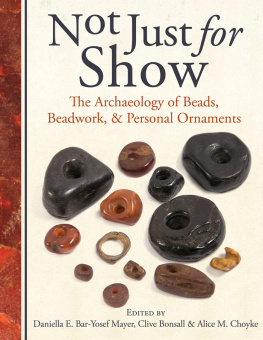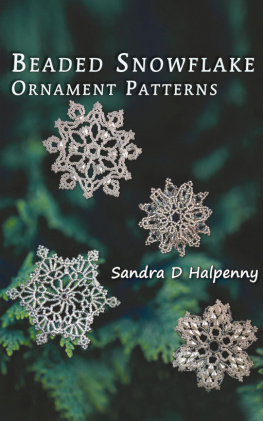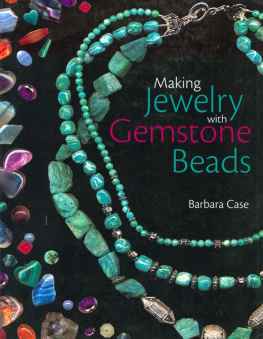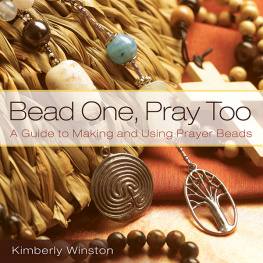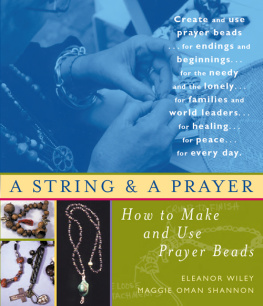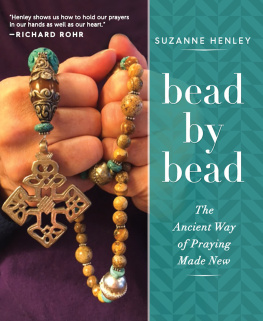
Published in the United Kingdom in 2017 by
OXBOW BOOKS
The Old Music Hall, 106108 Cowley Road, Oxford OX4 1JE
and in the United States by
OXBOW BOOKS
1950 Lawrence Road, Havertown, PA 19083
Oxbow Books and the individual authors 2017
Hardback Edition: ISBN 978-1-78570-692-9
Digital Edition: ISBN 978-1-78570-693-6 (epub)
A CIP record for this book is available from the British Library
Library of Congress Cataloging-in-Publication Data
Names: Mayer, Daniella Bar-Yosef, editor. | Bonsall, Clive, editor. | Choyke, Alice Mathea, editor.
Title: Not just for show : the archaeology of beads, beadwork and personal ornaments / edited by Daniella E. Bar-Yosef Mayer, Clive Bonsall and Alice M. Choyke.
Description: Philadelphia : Oxbow Books, 2017. | Includes bibliographical references.
Identifiers: LCCN 2017025529 (print) | LCCN 2017027041 (ebook) | ISBN 9781785706936 (epub) | ISBN 9781785706943 (mobi) | ISBN 9781785706950 (pdf) | ISBN 9781785706929 (hb)
Subjects: LCSH: Beads. | Beadwork. | Decoration and ornament. | Antiquities. | Social archaeology.
Classification: LCC GT2250 (ebook) | LCC GT2250 .N68 2017 (print) | DDC 391.7dc23
LC record available at https://lccn.loc.gov/2017025529
All rights reserved. No part of this book may be reproduced or transmitted in any form or by any means, electronic or mechanical including photocopying, recording or by any information storage and retrieval system, without permission from the publisher in writing.
Printed in the United Kingdom by Short Run Press
Typeset in India by Lapiz Digital Services, Chennai
For a complete list of Oxbow titles, please contact:
UNITED KINGDOM
Oxbow Books
Telephone (01865) 241249, Fax (01865) 794449
Email:
www.oxbowbooks.com
UNITED STATES OF AMERICA
Oxbow Books
Telephone (800) 791-9354, Fax (610) 853-9146
Email:
www.casemateacademic.com/oxbow
Oxbow Books is part of the Casemate Group
Front cover and spine: Selection of beads from Ypenburg (B.Grishaver).
Back cover: Tear-shaped bone pendants, Hayonim Cave (D. Shaham).
Contents
| Alice M. Choyke and Daniella E. Bar-Yosef Mayer |
| Jane Balme and Sue OConnor |
| Caroline Peschaux, Grgory Debout, Olivier Bignon-Lau and Pierre Bodu |
| Emanuela Cristiani and Duan Bori |
| Ashton J. Spatz |
| Emily Mueller Epstein |
| Dana Shaham and Anna Belfer-Cohen |
| Annelou van Gijn |
| Jolanda E. M. F. Bos |
| Adrin Velzquez-Castro, Patricia Ochoa-Castillo, Norma Valentn-Maldonado, and Belem Ziga-Arellano |
| Tsim D. Schneider and Lori D. Hager |
| Maria Gurova and Clive Bonsall |
| Greg Campbell |
List of Contributors
JANE BALME Archaeology M257, University of Western Australia, 35 Stirling Highway Crawley, WA, Australia 6009 ()
DANIELLA E. BAR-YOSEF MAYER The Steinhardt Museum of Natural History and Institute of Archaeology, Tel Aviv University, Tel Aviv 69978, Israel, () and Peabody Museum of Archaeology and Ethnology, Harvard University, Cambridge MA 02138, USA
ANNA BELFER-COHEN Institute of Archaeology, The Hebrew University of Jerusalem, Mt. Scopus, Jerusalem 91905, Israel ()
OLIVIER BIGNON-LAU Maison de lArchologie et de lEthnologie-Ren Ginouvs, UMR 7041 ArScAn du CNRS, quipe Ethnologie Prhistorique, Paris, France ()
PIERRE BODU Maison de lArchologie et de lEthnologie-Ren Ginouvs, UMR 7041 ArScAn du CNRS, quipe Ethnologie Prhistorique, Paris, France ()
CLIVE BONSALL School of History, Classics and Archaeology, University of Edinburgh, Old Medical School, Teviot Place, Edinburgh EH8 9AG, UK ()
DUAN BORI Department of Archaeology and Conservation, SHARE, Cardiff University, Colum Drive, Cardiff CF10 3EU, UK ()
JOLANDA E.M.F. BOS BLKVLD&Bos, Patrijzenstraat 11, 2042 CL Zandvoort, the Netherlands ()
GREG CAMPBELL 150 Essex Road, Southsea, Hants, PO4 8DJ, UK ()
ALICE M. CHOYKE Central European University, Medieval Studies Department, Nador u. 9, 1051 Budapest, Hungary
EMANUELA CRISTIANI McDonald Institute for Archaeological Research, University of Cambridge, Downing Street, Cambridge CB1 3ER, UK ()
GRGORY DEBOUT Service Archologique Dpartemental des Yvelines. Maison de lArchologie et de lEthnologie-Ren Ginouvs, UMR 7041 ArScAn du CNRS, quipe Ethnologie Prhistorique, Paris, France ()
ANNELOU VAN GIJN Faculty of Archaeology, Leiden University, PB 9514, 2300 RA Leiden, Netherlands ()
MARIA GUROVA National Institute of Archaeology and Museum, Bulgarian Academy of Sciences, 2 Saborna Str., 1000 Sofia, Bulgaria ()
LORI D. HAGER Pacific Legacy, Inc., Berkeley, CA 94707
EMILY MUELLER EPSTEIN Commonwealth Heritage Group, 3225 Central Street, Dexter, MI 48130, USA ()
SUE OCONNOR Archaeology and Natural History, College of Asia and the Pacific, The Australian National University, ACT, Australia 0200 ()
PATRICIA OCHOA-CASTILLO Museo Nacional de Antropologa, Instituto Nacional de Antropologa e Historia, Av. Paseo de la Reforma y calzada Gandhi s/n, Col. Chapultepec Polanco, Mxico D.F. 11560 ()
CAROLINE PESCHAUX Universit de Paris 1 Panthon- Sorbonne. Maison de lArchologie et de lEthnologie-Ren Ginouvs, UMR 7041 ArScAn du CNRS, quipe Ethnologie Prhistorique, Paris, France ()
TSIM D. S CHNEIDER Department of Anthropology, University of California, Santa Cruz, CA 95064 ()
DANA SHAHAM Institute of Archaeology The Hebrew University of Jerusalem, Mt. Scopus, Jerusalem 91905, Israel ()
ASHTON J. SPATZ College of DuPage, 425 Fawell Blvd., Glen Ellyn, IL. 60137, USA (); Moraine Valley Community College, 9000 W. College Pkwy., Palos Hills, IL. 60465, USA
NORMA VALENTN-MALDONADO Subdireccin de Laboratorio y Apoyo Acadmico, Instituto Nacional de Antropologa e Historia, Moneda 16, Centro Histrico, Mxico D.F. 06060 ()
ADRIN VELZQUEZ-CASTRO Museo del Templo Mayor, Instituto Nacional de Antropologa e Historia, Seminario 8, Centro Histrico, Mxico D.F. 06060 ()
BELEM ZIGA-ARELLANO 7a Temporada del Proyecto Templo Mayor, Museo del Templo Mayor, Seminario 8, Centro Histrico, Mxico D.F. 06060 ()
Introduction: The Archaeology of Beads, Beadwork and Personal Ornaments
Alice M. Choyke and Daniella E. Bar-Yosef Mayer
Beads are commonly defined as being small ornaments perforated through their centers and small enough to be worn on the body. Beads sewn on clothing, parts of composite body decoration from anklets, to bracelets, to girdles, to necklaces and to headbands may be identical or mixed in their size, shape and raw material (Dubin 2009). Beads can be strung in a series on a thread, sewn individually onto clothing, or traded as separate objects that can be counted. They can be dismantled from garments and body ornaments and shared between individuals or given from the living to the dead as part of burial ritual. Pendants are a type of bead that is perforated at one or both ends rather than symmetrically through the middle (Kenoyer 1991). They also can be part of a series of similar objects strung together on a filament of sorts or one of a kind, meant to be accentuated in a special way.
For anyone seriously studying beads, especially with the archaeological material, there is a frustration that most papers dealing with all their various manifestations tend to be scattered in isolated articles. This disarticulated publication record makes it particularly hard to see past the huge diversity of beads and bead use throughout human history. It becomes almost impossible to see patterning of any sort in the way humankind treated with this kind of ornamentation during its long history down to the present day. Theoretical modelling for tackling bead studies becomes extremely difficult and methodologies continue to be invented and re-invented. Consensus is virtually non-existent because of this lack of any sort of serious academic forum, at least within the world of archaeology. This volume of collected articles is intended to bring together specialists from diverse backgrounds and intellectual approaches, working on geographically separated bead material from the deep past as well as more historic material. The volume is intended to continue and reinforce a serious dialogue between practitioners. The approaches found here are all different but the intent is remarkably uniform. The authors all strive to understand the social forces at work behind the technical strategies, utilization and re-utilization of ornamentation in their particular part of the world and time period.
Next page
